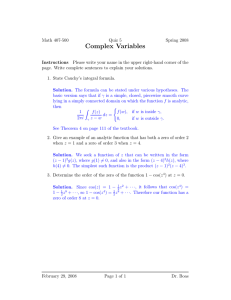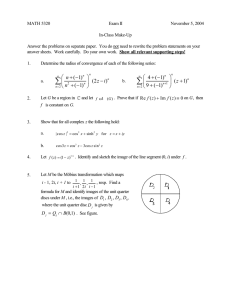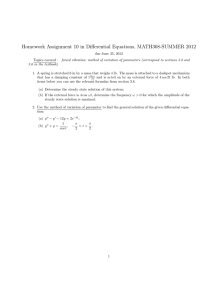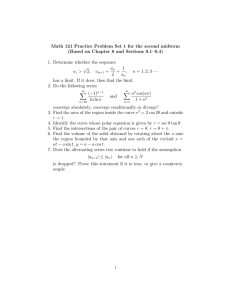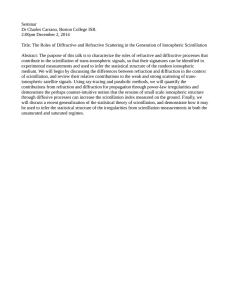The Roles of Diffractive and Refractive Scattering Charles S. Carrano
advertisement
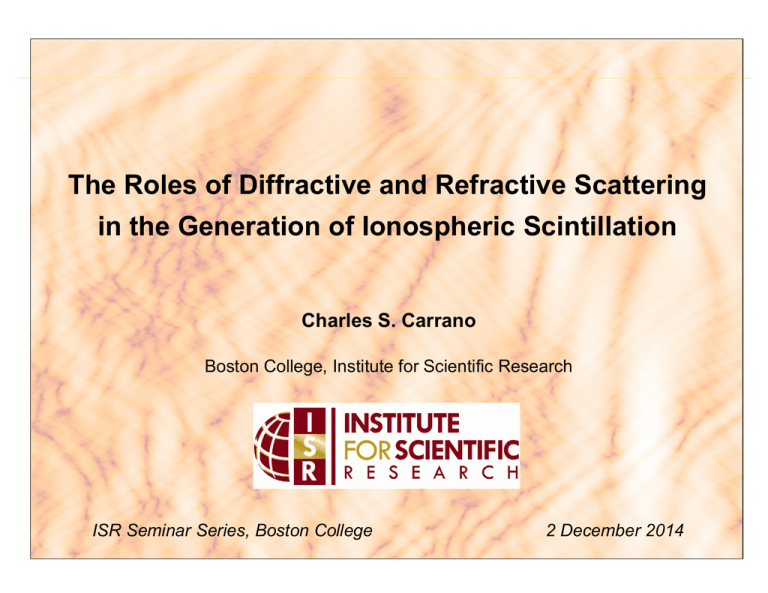
The Roles of Diffractive and Refractive Scattering
in the Generation of Ionospheric Scintillation
Charles S. Carrano
Boston College, Institute for Scientific Research
ISR Seminar Series, Boston College
2 December 2014
Purpose of this talk: characterize the roles of refractive and diffractive
processes that contribute to the scintillation of transionospheric signals,
so that their signatures can be identified in experimental measurements
and used to infer the statistical structure of the random medium.
Outline:
• Propagation past sinusoidal and general phase screens (tutorial)
• Propagation past power law phase screens (tutorial / new)
• The statistical theory of scintillation (new)
• Data analysis and Irregularity Parameter Estimation (new)
2
Scintillation Physics: A Simple Picture (Groves)
rec Ntot
τd R / c +
=
2π f 2
FROM SATELLITE
ΔNe
δφ
IONOSPHERE
Ntot
2π fR / c − rec
f
Radio Wave
Interference Pattern
Ntot = ∫ N e ( z )dz
VDRIFT
EARTH’S
SURFACE
•
Phase variations on wavefront from satellite cause diffraction pattern on ground
•
Interference pattern changes in time and space
•
User observes rapid fluctuations of signal amplitude and phase
3
Some Relevant Terminology
• Refraction is a change in direction of light due to a change in the physical properties
(refractive index) of the medium through which it travels. To conserve energy and
momentum the wave’s phase velocity changes but its frequency remains constant.
• Diffraction is due to the inherent wave nature of light. It also takes the form of bending
of the rays, but it is a manifestation of their constructive and destructive interference. It
does not follow such simple laws nor take place on as large a scale as refraction.
• Electromagnetic Scattering is the process whereby light radiation is forced to deviate
from a straight trajectory by one or more paths due to localized non-uniformities in the
medium through which they pass.
• Fresnel scale - the transverse distance from the direct path for which the Huyghens
wavelet is in quadrature with the resultant signal. Thus, a small phase change produced
by irregularities this distant from the direct path produces a change in signal amplitude.
• Diffractive scattering is caused by irregularities smaller than the Fresnel scale.
• Refractive scattering is caused by irregularities larger than the Fresnel scale.
References: Buttler, H. E., 1951; Budden, 1965; Booker, H. G. and MajidiAhi, 1981.
4
Focusing and Defocusing
Figure from Dennis Knepp, 2008 URSI Mtg.
5
The Phase Screen Concept
TX
Equivalent
screen
3D random medium
RX
An equivalent thin screen placed at the middle of an extended random medium can be
constructed to exactly reproduce the amplitude and phase fluctuations on the ground.
Essentially, the physical process of weak scattering from many of irregularities is
replaced by a single (possibly strong) scattering at the phase screen.
6
Refraction and Diffraction
(Simple Geometric Arguments)
7
Weak Scatter from a Sinusoidal Phase Screen
Consider a thin screen that imparts a sinusoidal phase change:
φ ( x ) = φ0 cos ( Kx )
1
to an incident monochromatic plane wave of unit intensity:
2π / K
E ( x, z , t ) = ei ( kz −ω t )
(to simplify notation, we’ll drop the “fast” variation e
i ( kz −ω t )
The field just below the screen is:
E + ( x, 0 ) = e
iφ0 cos( Kx )
If the perturbation is small, (φ0
1)
z
)
1 + iφ0 cos( Kx)
Briggs, 1975 and Hewish, 1989
we can Taylor expand exponential to first order:
e x =1 + x +
This gives the weak scatter approximation for the field just past the screen:
E + ( x, 0 ) ≈1 + iφ0 cos( Kx)
incident
scattered
8
Weak Scatter from a Sinusoidal Phase Screen
Compare the scattered field
Es ( x,0) = iφ0 cos( Kx)
with the sum of two plane waves propagating at angles ±θ to the zenith:
Es ( x, z ) = A ei ( kz cos θ + kx sin θ ) + A ei ( kz cos θ − kx sin θ )
1
2π / K
At the screen:
Es ( x, 0 ) = 2 A cos(kx sin θ )
these are equal if
A=
1 iφ and
2 0
sin θ = K / k
1 iφ
2 0
θ
1 iφ
2 0
z
E0
We have decomposed the scattered field into its angular spectrum of plane waves
The scattered plane waves must travel a longer slant distance than the incident wave.
Hence phase differences accumulate as the waves propagate, and interference occurs.
9
Weak Scatter from a Sinusoidal Phase Screen
Given the angular spectrum of plane waves at the screen, we can determine the field
at any distance past the screen as the superposition of these plane waves:
Es ( x, z ) = iφ0 cos( kx sin θ )eikz cosθ
= iφ0 cos( Kx)e
k −K
2
ikz 1− K 2 / k 2
≈ iφ0 cos( Kx)eikz e −i
K2
2k
2
K
φ0 cos( Kx) sin( 2 k
z
assuming
2
K
z ) + i cos( 2 k
If we express the total field past the screen as
2
k
θ
K / k 1
K
z ) eikz
=
E e χ + iS ≈ 1 + χ + iS
then we can identify the log amplitude and phase departure of the scattered field:
χ ( x, z )
2
K
= φ0 cos( Kx) sin( 2 k
z )eikz
S ( x, z )
2
K
= φ0 cos( Kx) cos( 2 k
z )eikz
10
Weak Scatter from an Arbitrary Phase Screen
For weak scatter the problem is linear and we can express the scattered field beneath
an arbitrary phase screen as a superposition of scattered sine (and cosine) waves:
Es ( x, z ) = i
∞
∫−∞ φ0 ( K ) e
χ ( x, z ) = ∫
∞
S ( x, z ) = ∫
∞
− i K2 k z iKx
2
e
2
K
φ ( K )sin( 2 k
−∞ 0
2
K
φ ( K )cos( 2 k
−∞ 0
dK
z ) eiKx dK
z ) eiKx dK
Under these conditions the Spectral Density Functions (SDF) of χ and S are directly
related (i.e. on a per wavenumber basis) to the SDF of the phase due to the screen:
Φχ (K
=
)
2 K2
sin ( 2 k
z ) Φφ ( K )
Φ S (=
K ) cos 2 ( K2 k z )Φφ ( K )
2
Φ χ ( K ) + Φ S ( K ) = Φφ ( K )
As a consequence, the statistical properties of the medium are directly related to the
statistics of measured amplitude and phase fluctuations on the ground.
11
Weak Scatter from an Arbitrary Phase Screen
For weak scatter, the Spectral Density Function of χ and S are Fresnel filtered versions
of the SDF of the variations in the screen:
z=350km
Φχ (K
=
)
2 K2
sin ( 2 k
z ) Φφ ( K )
ℑχ ( K )
Φ S (=
K)
2 K2
cos ( 2 k
z ) Φφ ( K )
ℑS ( K )
ℑχ ( K )
ℑS ( K )
Kz / k
The amplitude fluctuations are high-pass filtered with cutoff L = 2λ z (Fresnel scale)
so they cannot be used to probe the large scale structure of the medium. The phase filter
passes the large scale components.
The amplitude and phase are notch-filtered as spectral components of the wave are
alternately converted from phase to amplitude fluctuations with distance from the screen.
12
Fresnel Zone – A Geometric Picture
Plane wave
The multipath signal (red) travels the extra path length D:
TX
D=
ρ
•
scatterer
ρ 2 + z2 − =
z z
RX
−z
If ρ/z<<1 can expand in Taylor series:
2
ρ
D ≈ z 1+ (ρ z) − z =
2
2z
1
z
( ρ z )2 + 1
2
The first Fresnel zone defines the volume where
wavefronts interfere constructively (D<λ/2).
Fresnel zone radius: ρ =
λz
The Fresnel zone defines the most effective turbulent cell size in producing scintillation
at distance z past the screen. Smaller cells contribute less to scintillation because of the
weaker refractive index fluctuations associated with them, and larger cells do not
diffract light through a large enough angle to reach the receiver at z. – Driggers, 2003
This description applies in weak scatter only where the scattering angle θ ≈ K/k is
independent of screen strength. In strong scatter, larger scales also contribute.
13
Strong Scatter from a Sinusoidal Phase Screen
If the phase perturbation is larger (~1), we must keep higher order terms when expanding
the exponential (let’s start with 2nd order): e x =1 + x + 1 x 2
E0
2
With this approximation the field just after the screen is:
2π / K
E + ( x, 0 ) ≈1 + iφ0 cos( Kx) − 12 φ02 cos 2 ( Kx)
incident
scattered
θ 2θ
E0
z
Using a trigonometric identity (double angle formula) this can be written
E + ( x, 0 ) ≈ 1 − 14 + iφ0 cos( Kx) − 14 φ02 cos(2 Kx)
incident
scattered
Comparing the scattered field with the sum of 2 pairs of plane waves propagating at
angles ±θ1 , ±θ 2 to the zenith gives the amplitudes and scattering angles:
1 iφ , sin θ =
1 φ 2 , sin θ =
A1 =
K
/
k
A
=
−
1
2
2 2K / k
2 0
8 0
14
Strong Scatter from a Sinusoidal Phase Screen
Given the angular spectrum of plane waves at the screen the field at any distance past
the screen can be expressed as the superposition of these waves:
Es ( x, z ) = iφ0 cos( kx sin θ1 )eikz cosθ1 − 14 φ02 cos( kx sin θ 2 )eikz cosθ 2
iφ0 cos( Kx )e
ikz 1− K 2 / k 2
≈ iφ0 cos( Kx)eikz e −i
K2
2k
z
ikz 1−(2 K ) 2 / k 2
2
1
− 4 φ0 cos(2 Kx)e
− 14 φ02 cos(2 Kx)e −i
( 2 K )2
2k
z
The field at the ground now contains higher frequency content than the phase screen.
This is a consequence of the non-linearity associated with strong scatter.
15
Strong Scatter from a Sinusoidal Phase Screen
Let’s revisit the wavefield just past the screen, with no limitation for screen amplitude φ0
E + ( x, 0 ) = e
iφ0 cos( Kx )
E0
Generating function for the Bessel function:
e
iφ0 cos( Kx )
∞
=
∑
n =−∞
2π / K
i n J n (φ0 ) einKx
J n (φ0 )
E0
Comparing with sum of plane wave pairs at the screen
∞
Es ( x, 0 ) = 2
gives the amplitudes
z
∑ An cos(kx sin θn )
n =1
J n (φ0 ) and scattering angles sin θ n = ± ( nK / k ) at the screen.
Final result is a Fourier series:
E ( x, z ) = e
iπ /4
∞
∑
n =−∞
J n (φ0 ) e
− in 2 ( K 2 /(2 k )) z inKx
e
Spectral amplitudes
Even though the screen has content at a single frequency, the intensity field is broadband
16
How Broadband is the Diffraction Pattern?
Jn(ϕ0 =80)
Order n
The Fourier series effectively terminates at n ~ ϕ0
The intensity varies on wavenumbers up to nK = ϕ0K (this is called the diffraction scale).
The deeper the screen (i.e. the larger ϕ0) the more broadband the diffracted field will be.
17
Compare with Refraction from a Sinusoidal Screen
•
An observer close to the screen will see a single image refracted by an angle dictated
by the local phase gradient
K
1 dϕ
= − φ0 sin( Kx)
θr =
k dx
k
Far behind the screen at a distance z >> (Kθr), where the refracted rays reach the
observer from many points in the screen, the observer sees multiple images of the
source contained with an angular range set by the extreme value
•
θr
K
φ0
k
•
This is consistent with the maximum scattering angle predicted by diffraction.
•
However, the predictions of refraction are incorrect when the phase screen is weak.
(Recall that in weak scatter θ ≈ K/k was independent of screen strength).
18
Strong Scatter from a Sinusoidal Phase Screen
Phase
screen
Focal
distance
(k/φ0K2)
Reception
plane
Diffraction
Refraction
Caustic
Refraction
captures signal
“envelope” but
diffraction creates
the small scale
structure.
19
Still Stronger Scatter from a Sinusoidal Phase Screen
Phase
screen
Focal
distance
(k/φ0K2)
Reception
plane
Diffraction
Refraction
Caustic
20
Power Law Phase Screens
21
In-Situ (1D) Power Law Spectra from C/NOFS PLP
Rino, C. L., C. S. Carrano, and P. Roddy (2014), Wavelet-based analysis and
power law classification of C/NOFS high-resolution electron density data,
Radio Sci., 49, 680–688, doi:10.1002/2013RS005272.
The phase spectral index p is one larger than the in-situ spectral index, p(1)
Observations generally fall in the range 2.5 < p < 4
22
Power Law Phase Screens
Fully developed turbulence – Shallow Screen p<3
Decaying turbulence – Steep Screen p>3
These screen realizations have the same large scale structure,
but the shallower spectra realization has more small scale structure.
23
Steep Spectra - Refraction Dominated Scintillation
Phase
screen
Reception
plane
Diffraction
For this φ0 and
distance past the
screen, refraction
alone can explain
the observed
scintillation
Refraction
At greater
distances past
the focal plane
refractive focusing
contributes less,
whereas the small
scale diffraction is
always present.
24
Steep Spectra - Refraction Dominated Scintillation
Lowpass filtered at Fresnel Frequency/4
Phase
screen
Reception
plane
Diffraction
Removal of small
scale structure
leaves pure
refractive
scattering.
Refraction
The true S4
index (red) has
decreased slightly,
which seems
reasonable given
that we have
weakened the total
perturbation.
25
Shallow Spectra - Diffraction Dominated Scintillation
Phase
screen
Reception
plane
Diffraction
Refraction
There is plenty
of refraction, but the
net effect is minimal
(no focusing)
In this example, the
reception plane is in
the far field where
only small-scale
diffraction contributes
Presence of multiple
scale sizes each with
different focal lengths
causes focusing
effects to average
out.
Many rays pass
through each point
on the ground, and
we must account
for their interference
26
Shallow Spectra - Diffraction Dominated Scintillation
Lowpass filtered at Fresnel Frequency/4
Phase
screen
Reception
plane
As before,
removal of small
scale structure
leaves pure
refractive
scattering.
Diffraction
Refraction
The true S4
index (red) has
increased, since
removal of small
scale structure
mitigates the
diffraction and
promotes focusing.
27
Statistical Theory of Scintillation
28
Phase Screen Theory
ΦI (q)=
• Spectrum of intensity fluctuations:
{
}
2
exp
−
g
r
,
q
ρ
(
F ) exp( −iqr ) dr
∫
Fresnel scale: ρF=(z/k)1/2
• Structure interaction term:
• Intensity correlation:
• Scintillation index:
R (=
r)
g (r1 , r2=
) 8∫ Φ I ( q ) sin 2 (r1q / 2)sin 2 (r2 q / 2) dq/ 2π
1
2π
∫ Φ ( q ) cos(qr )dq
I
1
S 42 =
2π ∫ Φ I ( q ) dq − 1
29
Two-Component Structure Model (Rino)
Phase spectrum:
q − p1 ,
q < q0
Φδφ (q ) =
Cp p − p − p
2
1
1
q0 q , q > q0
p1=0 gives an outer scale
p1=p2 gives an unmodified power law
p2>p1 gives a two-component spectrum
Phase PSD
p1
p2
q0
q
30
Compact Strong Scatter Model (Rino)
• We use the Fresnel scale to normalize the phase and intensity spectra:
U1µ − p1 ,
P( µ ) =
Φδφ µ ; ρ F / ρ F =
p −p −p
U 2 µ0 2 1 µ 2 ,
(
(
)
µ ≤ µ0
µ > µ0
)
I (µ ) =
Φ I µ; ρF / ρF =
∫ exp{−γ (η , µ )} exp(−iηµ )dη
Normalized spatial wavenumber: µ = q ρ F
p1 −1
p2 − p1 p2 −1
,
=
U1 C=
ρ
U
C
q
ρF
Normalized turbulent strength parameters:
2
p F
p 0
• Next, define U* as the normalized phase spectral power at the Fresnel scale
U1 , q0 ρ F ≥ 1
U =
U 2 , q0 ρ F < 1
*
• Then parameters p1, p2, µ0, and U* specify all solutions for 2-component spectra
(i.e. different combinations of perturbation strength, propagation distance, and
frequency produce exactly the same results).
31
Intensity PSD
Single-Component Power-Law with p=2.5
Increasing U
(screen strength
or distance)
Non-dimensional Wavenumber
Significant departures from power law behavior occur when the scatter is strong.
In particular, note the low frequency enhancement and spectral broadening.
32
Intensity PSD
Single Component Power-Law with p=3.5
Increasing U
(screen strength
or distance)
Non-dimensional Wavenumber
33
Two Component Power-Law with p2=2.5
If we erode large scale irregularity structure, the low frequency enhancement is suppressed.
The low frequency enhancement is a consequence of large scale refractive focusing. It is
primarily responsible for driving S4 above unity – this is referred to as strong focusing.
34
Two Component Power-Law with p2=3.5
If we erode the large scale irregularity structure in this case, two things happen. As with the
shallow slope case, the low frequency enhancement is suppressed. In the steeply sloped
case, however, the spectral broadening at high frequencies is also suppressed.
We can infer that focusing by large scale irregularity structure is responsible for the high
frequency spectral broadening. This refractive scattering effect is commonly observed in
late-night scintillation following the decay of small scale irregularities.
35
Development of the Scintillation Index (S4)
Unmodified power law
Unmodified power law spectra with p>3 admit sustained quasi-saturation states with S4>1
Outer scale µ0=0.1
An outer scale suppresses strong focusing, driving S4 to unity (from above if p>2)
36
Development of the Correlation Length
Unmodified power law
Outer scale µ0=0.1
For shallow spectra, correlation length is completely unaffected by presence of outer scale.
For steep spectra, suppression of refractive focusing greatly increases correlation length. 37
Diffractive and Refractive Scattering at Ascension Island
38
Campaign at Ascension Island in March 2000
•
Geostationary satellites broadcasting radio signals at UHF (250 MHz) and
L-band (1535 MHz) were monitored along nearly co-linear links.
•
The UHF data were acquired using spaced antennas to measure the zonal
irregularity drift.
FLEETSAT F8
(250 MHz)
•
INMARSAT 3-F2
(1535 MHz)
Receiver: 7.898°S, 14.38°W, DEC -.3°
•
16°
9°
350 km
Side View
•
RX
39
Intensity and Decorrelation Time
22-23 March 2000
I
I
40
Irregularity Parameter Estimation (IPE)
Early evening bubbles (both UHF and L-band in saturation with S4~1)
UHF
L-band
• When scatter is strong the intensity spectra deviate from power-law form
(hence the irregularity parameters cannot be measured directly).
• Nevertheless, the irregularity parameters may still be inferred by non-linear
least-squares fitting to the 4th moment in the frequency domain.
41
Irregularity Parameter Estimation (IPE)
Two hours later (UHF in strong focusing, L-band in weak scatter)
L-band
UHF
Flat segment
here suggests
Φδφ (q ) ∝ q
−4
• Because L-band is in weak scatter, in this case, we see direct
evidence of the underlying two-component irregularity spectrum.
• Weak scatter theory predicts:
q 4 Φδφ (q ),
I (q) ∝
Φδφ (q ),
q qf
q qf
42
Reconciliation of S4 at UHF & L-band
Strong
focusing,
S4>1
Strong focusing, S4>1
43
Structure Model Parameters
Focusing at UHF occurs more frequently as the break scale increases.
44
Universal Scaling Parameter, U*
45
Evolution of Irregularity Structure
UHF L-band
As local time increases, the Fresnel scale at UHF lies more fully in the
steeply sloped region. This promotes strong focusing.
46
Conclusions (1)
• In weak scatter there is a direct relationship between scales in the diffraction
pattern and the corresponding scales of phase variations in the random
ionospheric medium.
• Since amplitude fluctuations are high-pass filtered they cannot be used to
probe large the scale structure. Phase fluctuations are sensitive to large scale
structure but can be difficult to interpret in strong scatter.
• When scatter is strong, large scale structures can contribute to the scintillation
via refractive scattering. Efficiency of refractive scatter depends on the spectral
index (p>3 is required for significant focusing) and proximity to the screen.
• For a given perturbation strength, focusing plays a decreasing role with
increasing distance past the focal plane (which varies with scale) but the
small scale diffraction is always present.
47
Conclusions (2)
• Early at night we often observe fully developed turbulence (p<3) in saturation
(S4 ~1). The presence of small scale structure suppresses the efficiency of
refractive focusing.
• Late at night small scale features decay via diffusive processes, resulting in
more steeply sloped spectra (p>3). This condition makes refractive focusing
more efficient and produces S4 values exceeding 1.
• At Ascension Island we observed 2-component spectra with largely
unchanging slopes; the dominant effect was migration of the spectral break to
larger scales over time.
• This caused the UHF signal to progressively “feel” more of the steeply sloped
region (which admits strong focusing), and less of the shallow sloped region
(which does not).
48

